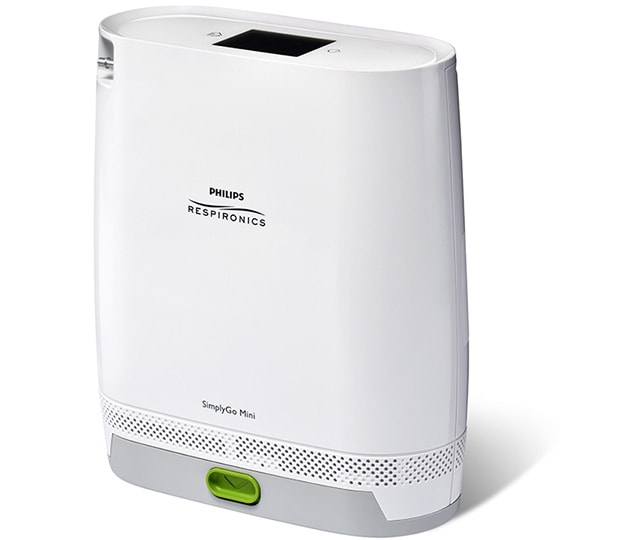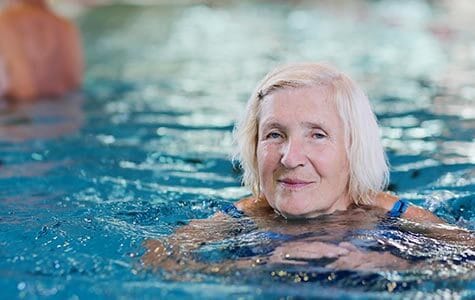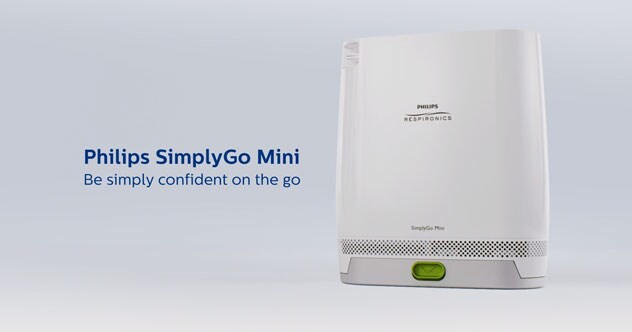SimplyGo Mini
A lightweight portable oxygen concentrator (POC) that gives you freedom for life.

Easy to read and use LCD touchscreen, with five pulse dose settings to keep you on the go Lightweight, easy to carry and travel-ready (complies with FAA requirements for in-flight use*) Rugged construction combines with elegant design for confidence outside your home Simple to replace rechargeable battery that lasts up to 4.5 hours (up to 9 hours with extended battery)**
*RTCA/DO-160G section 21, category M **Battery duration times are based on new, fully charged batteries used with a new SimplyGo Mini system. Battery duration times will degrade with battery age, environmental operating conditions, use over time, and operational condition of the concentrator.
Request a SimplyGo Mini brochure
Request a SimplyGo Mini brochure
SimplyGo Mini is a breakthrough in lightweight portable oxygen therapy.
From a walk in the park to a weekend away with friends, SimplyGo Mini’s reliable performance and stylish look could be just what you need to get back to living life your way, with confidence.
Living and competing with COPD
Russell Winwood is a triathlete and marathon runner living with COPD. He is still able to compete in long-distance events with the help of the Philips SimplyGo Mini.
Portable oxygen makes a difference
Mark Junge is a bike adventurer and has COPD. Hear his perspective on how portable oxygen treatment can help others with COPD stay active and empowered.
COPD solutions

Oxygen SimplyGo portable oxygen concentrators that give you freedom and mobility to live your life with confidence.

Nebulizers COPD nebulizers deliver your medication where it's needed most - your lungs. Many medications begin to work much quicker as a result3.

Daily COPD management Airway clearance devices, peak flow meters, muscle training and holding chambers to help you manage and prevent symptoms.
Tips and inspiration:
Ideas and insights about living with COPD, empowering you to live life to the fullest while managing your condition.
With COPD, breathing can be difficult.
Living life doesn’t have to be.
COPD is estimated to affect more than 210 million people worldwide1 as the fourth leading cause of death, and is becoming more prevalent every day2. But through education, engagement, and empowerment we can help those affected by the disease live a fulfilling life. Learn more about World COPD Day and how you can help support the COPD Foundation with a donation from Philips.
Frequently asked questions
- What is COPD?
-
COPD is a term that covers a number of progressive lung conditions that make breathing difficult, including chronic bronchitis and emphysema¹. One of the main causes is prolonged exposure to cigarette smoke, especially if the smoke is inhaled. However, breathing in second hand smoke, air pollution, chemical fumes and dust from the environment or workplace can also cause COPD².
1. Web MD. What is chronic obstructive pulmonary disease (COPD)?
www.webmd.com/lung/copd/tc/chronic-obstructive-pulmonary-disease-copd-overview
Accessed on 4 August 20152. Web MD. 10 FAQs About Living With COPDWhat is chronic obstructive pulmonary disease (COPD)?
www.webmd.com/lung/copd/10-faqs-about-living-with-copd#2
Accessed on 5 August 2015 - What are the symptoms of COPD?
-
A chronic cough, one that lasts for several weeks without the presence of other illness such as cold or flu, is the first sign of COPD. The cough is usually worse early in the morning, and may be aggravated by exercise or smoke. Other typical symptoms include shortness of breath, wheezing, tightness in the chest and increased mucus (or phlegm) production 1,2.
1. Healthline. Six signs of COPD.
www.healthline.com/health-slideshow/copd-symptoms#9
Accessed on 24 June 2015.2. European Lung Foundation. Lung Factsheet: Living well with COPD.
www.european-lung-foundation.org
Accessed on 19 June 2015. - What causes COPD?
-
One of the main causes of COPD is prolonged exposure to cigarette smoke, especially if the smoke is inhaled. But breathing in secondhand smoke, air pollution, chemical fumes or dust from the workplace also can cause the condition1.
These inhaled particles can cause the mucus glands that line the bronchi to produce more mucus than normal. In addition, the inflammation that they trigger causes the walls of the bronchi to thicken and swell. Environmental factors and genetics may also play a part in the development of COPD 1,2.1. Web MD. 10 FAQs About Living With COPDWhat is chronic obstructive pulmonary disease (COPD)?
www.webmd.com/lung/copd/10-faqs-about-living-with-copd#2
Accessed on 5 August 20152. medicinenet.com. Chronic Bronchitis
www.medicinenet.com/chronic_bronchitis/page3.htmAccessed on 5 August 2015.
- How is COPD treated?
-
Although there is no cure for COPD, there are many effective treatments available to help you manage your symptoms and slow the progression of COPD, so that you can live an active life1.
1. Healthline. COPD and You: Managing Your Symptoms.
www.healthline.com/health/copd/and-you-symptom-management#1Accessed on 10 July 2015.
- How will my illness progress?
-
COPD has four stages, each one with different symptoms of increasing severity. However, by monitoring your symptoms and effectively managing them, it is possible to slow the progression of the disease and to enjoy a more active life1,2.
1. Healthline. COPD and You: Managing Your Symptoms.
www.healthline.com/health/copd/and-you-symptom-management#1Accessed on 10 July 2015.
2. Healthline. COPD: Symptoms and Stages.
www.healthline.com/health/copd/stages#Overview1Access on 6 June 2015.
- What is pulmonary rehab?
-
Combining a program of exercise, education and support, pulmonary rehab can help you live more comfortably with COPD by increasing your capacity for exercise and improving your mobility. You’ll learn about effective breathing techniques, relaxation exercises, the use of medication and oxygen, good nutrition and travel tips, as well as how to avoid flare-ups and stay healthy. Pulmonary rehab also provides an opportunity meet others with COPD to exchange experiences, provide mutual encouragement and increase determination to improve fitness levels and fight the disease1.
1. American Association of Cardiovascular and Pulmonary Rehabilitation (AACVPR). Pulmonary Rehabilitation.
www.copdfoundation.org/Portals/0/Files/pdfs/AACVPR-FactSheet.pdf
Accessed on 6 June 2015. - Is COPD hereditary?
-
Genetics can play a part in the development of COPD, even if you have never smoked or been exposed to pollutants for an extended period of time. In particular, emphysema can be triggered by a deficiency in alpha-1 antitrypsin (AAT), which is a protein that protects the lungs from the harmful effects of white blood cells in the lungs. However, not everyone with COPD who has never smoked has a deficiency on AAT, so it is believed that there must be other genetic triggers for COPD1.
1. COPD Foundation:
www.copdfoundation.org/What-is-COPD/Understanding-COPD/What-is-COPD.aspx#sthash.PjPozNK3.dpufAccessed on 23 June 2015.
- Are there actions I can take to manage my COPD?
-
There are a number of things you can do that will greatly help you to manage your COPD1,2.
- Stop smoking
- Take regular exercise
- Eat well and maintain a healthy weight
- Practice breathing and relaxation techniques
- Learn how to cough effectively
- Recognize and avoid the factors that trigger flare-ups
- Have an action plan for flare-ups
- Take your medications as prescribed
- See your doctor regularly, even if you feel well, and especially if you have any concerns
- Find out if you qualify for pulmonary rehabilitation
References
1 COPD Foundation, COPD Uncovered Report. 2011. Retrieved from: https://www.copdfoundation.org/pdfs/copd-uncovered-report-2011.pdf 2 Lozano R, Naghavi M, Foreman K, et al. Global and regional mortality from 235 causes of death for 20 age groups in 1990 and 2010: a systematic analysis for the Global Burden of Disease Study 2010. Lancet 2012; 380(9859): 2095-128. 3 Livestrong.com. What Are the Benefits of Nebulizers? http://www.livestrong.com/article/557219-what-are-the-benefits-of-nebulizers/ Accessed on 4 August 2015.





